Disc thickness variation— warped brake rotors
What is disc thickness variation (rotor warp) and how to eliminate it
Disc thickness variation (DTV) is a brake rotor condition where 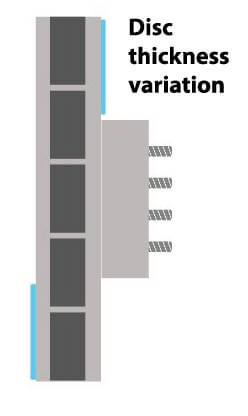 opposite faces of the brake rotor accumulate an extra thickness of brake friction material or thinness due to uneven wear.
opposite faces of the brake rotor accumulate an extra thickness of brake friction material or thinness due to uneven wear.
When a brake rotor develops DTV it causes brake pedal pulsation during braking. Most people refer to this as rotor warp. But rotors don’t warp. In fact, the braking system on stock cars and trucks can’t possibly generate enough heat to warp a brake rotor. Don’t believe me? See this post on brake rotor warp and why it’s not physically possible to warp a brake rotor.
A rotor with DTV causes a floating brake caliper piston to extend or compress into the caliper bore as the thicker or thinner portion of the rotor passes past the brake pads. Since the piston is moving either out or in, it causes the brake fluid pressure to rise or fall, causing the driver to feel a rising or falling brake pedal during braking. Brake pedal pulsation caused by disc thickness variation tends to get worse as the rotor heats up from extended braking
What causes disc thickness variation?
Lateral runout or uneven clamping forces are the two most 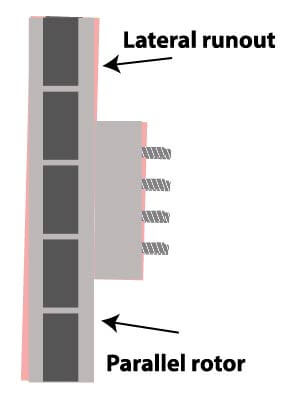 common causes of disc thickness variation. Lateral runout is a condition where the rotor doesn’t sit perfectly parallel to the wheel hub. That causes the rotor to rotate in a wobble pattern.
common causes of disc thickness variation. Lateral runout is a condition where the rotor doesn’t sit perfectly parallel to the wheel hub. That causes the rotor to rotate in a wobble pattern.
As the inner face of the rotor hits the inner brake pad it accumulates an extra layer of brake friction material if the brake pad is formulated with an adherent formula. If the brake pad is made with an abrasive formula, the brake pad will wear the inner face of the rotor and reduce its thickness every time it hits the inner pad. The opposite condition occurs on the opposite face. To learn more about the differences between an adherent versus abrasive friction material, see this post.
Lateral runout can be caused by uneven deposits of rust or dirt on the wheel hub. If the rust or dirt isn’t removed, the brake rotor will cock slightly when installed. In addition, uneven lug nut torque can also cause the rotor to mount in non-parallel orientation to the wheel hub. Lug nuts should always be tightened to the manufacturer’s specifications using a torque. Uneven lug nut torque is most often caused when lug nuts or bolts are tightened using an impact wrench.
Some shops rely on torque sticks that achieve a pre-determined amount of torque and spring backward between impact blows. Torque sticks are relatively accurate when new, 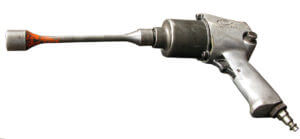 but their accuracy wanes overuse. Brake manufacturers recommend replacing torque sticks annually if they’re used in a shop environment.
but their accuracy wanes overuse. Brake manufacturers recommend replacing torque sticks annually if they’re used in a shop environment.
How to detect disc thickness variation
Measure the brake rotor thickness in at least 6 locations around the rotor using a micrometer. Brake manufacturers prefer zero DTV. Rotor thickness should be measured in at least six areas of the rotor’s face. DTV should not vary more than 0.001” from one spot to another. Measurements should be taken a quarter inch from the edge of the rotor.
Lateral runout greater than 0.006” is a sign that the wheel hub, rotor or wheel bearing should be replaced. The needle of the dial indicator should be perpendicular to the rotor. Measurements should be taken a quarter inch from the edge
Prevent or correct DTV
The best way to prevent lateral runout and DTV is to thoroughly 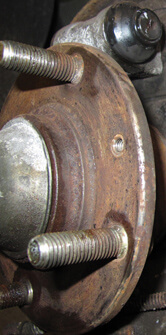 clean the wheel hub and inside the rotor hat prior to installing the
clean the wheel hub and inside the rotor hat prior to installing the 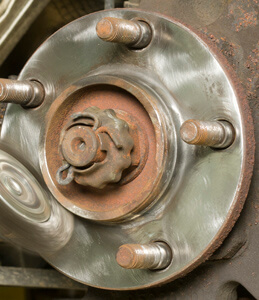 rotor.
rotor.
Assemble the wheel to the hub using a calibrated torque wrench to assure even lug nut torque.
If the brake rotor has developed DTV, correct the condition by machining with an on-vehicle brake lathe or by installing lateral runout shims by BrakeAlign. In severe situations, replace the rotors.
For more information on correcting brake pedal pulsation, see this post.
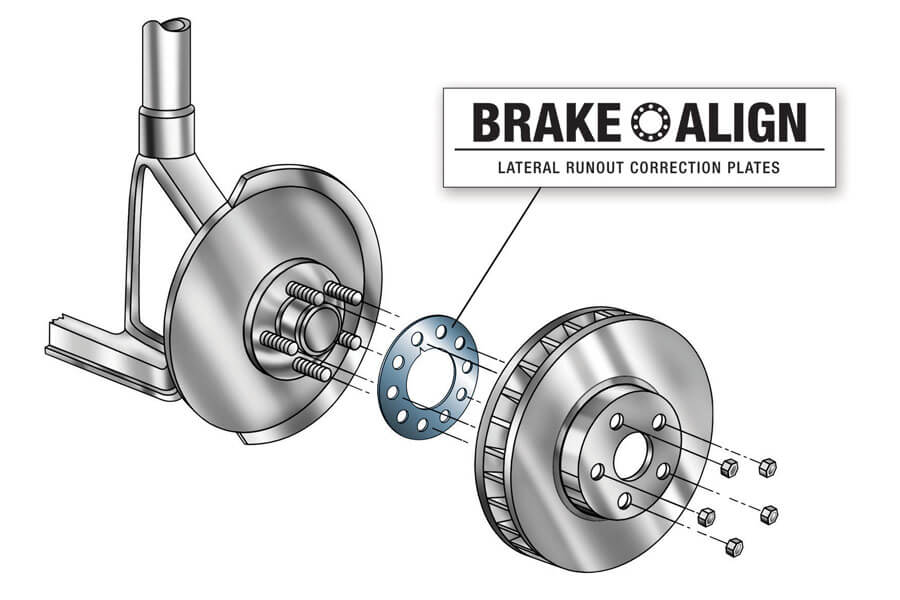
©, 2017 Rick Muscoplat
Posted on by Rick Muscoplat
